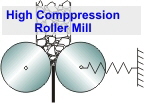|
The throughput is depending on the material, particle size, moisture content, roller diameter, roller length,
circumferential speed, roller surface structure and grinding force.
Further on the way of material feeding has an impact, e.g. the use of plug screws for the feeding of very fine materials
or the throttling of the mill forerun by adjustable steel plates in the feeding funnel. However these two methods are not analysed in the following because more or less all high compression roller mills
which are in use are working with a free flow of the material out of the filled funnel. Only for finest grindings below 0.02 mm plug screws are used.
|
|
The results which were published so far can be summarized in three general statements:
The throughput increases at first nearly proportional and above a material specific limit degressive with
increasing circumferential speed [2,3,4,5]. For materials with a bigger fraction of fines the backstreaming air causes a fluidisation at a circumferential
speed of 0.4 to 0.5 m/s what leads to a breakdown of the material entrainment [6]. This phenomena is known from the briquette technique with
rollers, see e.g. [7]; in this case it is necessary to use plug screws. The influence of the grinding force on the throughput is depending on material, graining and moisture content.
When feeding dry quartz, limestone, copper or gold ore and others the throughput does only change imperceptibly [2,5], for cement clinker and Rammelsberger ore a slight decrease
with increasing grinding force was observed [2]. A stronger decrease appeares with moist materials [5].
The test conditions and the mill sizes in the adduced publications were the following one:
[2] Schwechten: Lab scale mill, D = 200 mm, L = 100 mm, quartz,
limestone, cement clinker, Rammelsberger ore, 0.04 mm bis 8 mm, moisture content up to 39 Vol.-%, circumferential speed 0,2 bis 3,0 m/s.
[3] Plank, Bauerochse, Oberheuser: Pilot mill, D = 900 mm, L = 250 mm,
burned lime, limestone up to 10 mm, dry, circumferential speed 0.5 to 2.0 m/s.
[4] Patzelt, v. Seebach: Industrial mill, D = 1800 mm, L = 500
mm, cement clinker, 1 to 15 mm, dry, circumferential speed 0.2 to 1.8 m/s.
[5] Weller, Norgate, Sterns, Housley: Lab scale mill, D = 300 mm, L =
70 mm, copper ore, lead-zink ore, nickel and gold ore, bauxit, limestone, cement clinker, up to 19 mm, moisture up to 12 mass.-%, circumferential speed 0.375 and 0.75 m/s.
[6] Schwechten: Technical school, D = 300 mm, L = 100 mm, zircon
sand, product < 0,01 mm, dry, circumferential spped 0.22 bis 0.7 m/s, plug screw.
|



